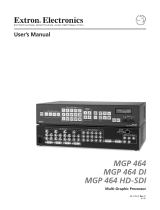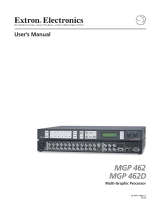Page is loading ...

030431.01
NEDERLANDS 2
ENGLISH 4
DEUTSCH 6
FRANÇAIS 8
ESPAÑOL 10
ITALIANO 12
Copyright © 2019 Vetus b.v. Schiedam Holland
Installatie instructies
Waterlock
Installation instructions
Waterlock
Einbauanleitung
Wassersammler
Instructions d’installation
Waterlock
Instrucciones de instalación
Colector
Istruzioni per l’installazione
Marmitte
MGP - MGS - MGL
Waterlock

vetus® Waterlock MGP, MGS, MGL
4 030431.01
1 Introduction
The Vetus exhaust system components are especially suitable for use
in water-injected exhaust systems.
The maximum continuous operating temperature of the plastic
components of the exhaust systems is 70 degrees C (158 degrees F).
The MGP, MGS and MGL waterlocks are available with the following
intake connections: 45° upward angle (standard), 30° upward angle,
15° upward angle or horizontal (on request and with a minimum of
10 pieces).
- Fit a temperature alarm to warn of excessively hot exhaust
system temperature.
- If the quantity of injected coolant water is reduced to in
order to lower back-pressure in the exhaust system, check
that there is still sufficient water injected when the engine
is ticking-over. This will prevent excess temperatures in the
exhaust system.
- Excess temperature can also be the consequence of insuf-
ficient mixing of coolant water with the exhaust gasses
In general, good mixing is obtained by a virtually vertically
installed exhaust injection bend
Poor mixing can also occur with an engine on tick-over;
especially when the coolant water injection bend is
installed virtually horizontally.
If necessary, take action. For example; by fitting a water
vortex or a water splitter in the exhaust pipe, to improve
the mixing of coolant water with the exhaust gasses.
With water-injected exhaust systems, fit a hose of suitable quality.
This hose must be reinforced, resistant to exhaust gasses, high
temperatures (100 degrees C, 212 degrees F) and oil. Easy flexibility
is essential for installation, while the hose must not collapse when
heated.
Vetus exhaust hose fulfils all the above requirements.
IN OUT
Engine power
to:
MGP9090 ø 90 mm (3.5”) ø 90 mm (3.5”) 77 kW (105 hp)
MGP102102 ø 102 mm (4”) ø 102 mm (4”) 100 kW (136 hp)
MGP102127 ø 102 mm (4”) ø 127 mm (5”) 127 kW (173 hp)
MGP5455 ø 127 mm (5”) ø 127 mm (5”) 155 kW (211 hp)
MGS5455A ø 127 mm (5”) ø 127 mm (5”) 155 kW (211 hp)
MGS5456A ø 127 mm (5”) ø 152 mm (6”) 188 kW (256 hp)
MGS6456A ø 152 mm (6”) ø 152 mm (6”) 222 kW (302 hp)
MGL6458A ø 152 mm (6”) ø 203 mm (8”) 308 kW (420 hp)
MGL8458A ø 203 mm (8”) ø 203 mm (8”) 396 kW (539 hp)
MGL84510A ø 203 mm (8”) ø 254 mm (10”) 508 kW (691 hp)
Warning
If water enters the engine from the waterlock into the exhaust
system (for example: under sail when the ship rolls or pitches
heavily) this will lead to irreparable damage to the engine.
Too much water in the waterlock can effect engine starting;
drain off this water first. Too much water in the waterlock can
be also caused by repeated starting attempts while the engine
refuses to start.
2 Installation
2.1 Installing waterlock MGP, MGS, MGL
Instal the waterlock as vertical as possible.
The waterlock ‘IN’-connection must always remain below the level
of the exhaust injection bend! Position the waterlock ‘back-to-front’
alongside the engine when there is insufficient space behind the
engine.
During operation, the waterlock will contain water. Its weight will
thus increase considerably.
Fit the waterlock on a level surface and attach it with M8 bolts and
3 flat washers.
2.2 Installing the transom exhaust connection
Fit the transom exhaust connection at such a position that with
the ship fully laden, the outlet is still at least 5 cm (2”) above the
waterline.
2.3 Exhaust pipe
In order to ensure the proper drainage of the coolant water injected
into the exhaust pipe, the pipe must be installed with a slope down-
ward over its whole length from the water injection point to the
waterlock.
During operation, the exhaust pipe will contain water. This will
increase its weight considerably, so support the exhaust pipe prop-
erly.
The exhaust pipe from waterlock to transom connection must be
installed in such a way that:
- The highest point in the exhaust pipe should not be more than
150 cm (60”) above the underside of the waterlock.
- The length of the section between the waterlock and the highest
point, should not exceed 300 cm (120”).

vetus® Waterlock MGP, MGS, MGL
030431.01 5
2.4 Hose connections
In to order to best connect the hose to the waterlock, the top por-
tion of the waterlock can be turned in a 360° radius.
The top portion should be turned as follows:
1 Loosen the clamping ring (A) by unscrewing the M6 bolts
2 Pull the top portion of the waterlock upwards
3 Turn the top portion to the desired position
4 Let the top portion down again
5 Re-attach the clamping ring (A) by screwing the M6 bolts back in
using a 2 Nm tightening torque
ENGLISH
note
Ensure that the O-ring is properly centred!
Screw on the M6 bolts at the same time.
note
Make sure the top part is not out of position!
2.5 Fitting the hose
To ease the fitting of the hose to the hose connector, use only water
and/or soap, NOT grease or products containing oil.
Fit each hose connection with 2 stainless steel 12 mm (0.5”) wide
hose clamps.
2.6 Sensor for temperature alarm
A sensor for a temperature alarm can be fitted in the exhaust pipe.
A sensor for a temperature alarm can also be fitted in the exhaust
silencer connector. The ‘IN’ connector on the exhaust silencer has
two circular areas. These are intended for fitting the temperature
sensor. Drill in one of these areas a hole of the correct size. Fit the
sensor with a lock nut and, after fitting, check that the exhaust
silencer is completely liquid and gas-tight.
3 Installation example
On p. 15, you will find a depiction of an exhaust system with a water-
lock of type MGP / MGS / MGL and a transom exhaust connection.
When the engine is stopped, any water which is still in the exhaust
pipe (between the highest point in the exhaust system and the
waterlock) will run back to the waterlock.
3.1 Prevention of syphoning (drawing 2)
If the water injection point ‘C’ is below, or less than 15 cm (0.6”) above
the waterline (also when the ship heels under sail), there is a risk that
when the engine is stopped, the coolant water will enter the engine
due to syphoning. This syphoning can be prevented in two ways:
By creating an air vent system in the coolant water hose between
engine block and water injection point ‘C’, by fitting an air vent
with air vent pipe, for example.
By fitting an air vent (with valve) in the coolant water hose
between the engine block and water injection point ‘C’.
4 Maintenance
• Check all hose connections for gas and water leaks regularly.
• Before the winter lay-up, drain the waterlock. The waterlock has a
drain plug for this purpose.
M6
2 Nm
10
A

vetus® Waterlock MGP, MGS, MGL
030431.01 15
6 Installatievoorbeeld
Installation example
Montagebeispiel
Exemple d’installation
Ejemplo de instalación
Esempio di installazione
min. 10 cm (4”)
B
min. 10 cm (4”)
1 2
C
A
WL
min. 40 cm (16”)
max. 150 cm
(5 ft)
min. 10 cm (4”)
min. 10 cm (4”)
5
C
A
min. 15 cm (6”)
B
min. 75 cm (3 ft)
WL
Uitlaatsysteem met waterinjectiepunt ‘C’
15 cm of meer boven de waterlijn
Exhaust system with water-injection point
‘C’ 15 cm or more above the waterline
Auspuffsystemen mit Wasserein-
spritzpunkt ‘C’ 15 cm oder mehr über der
Wasserlinie
Système d’echappement avec point
d’injection d’eau ‘C’ 15 cm ou plus
audessus de la ligne de flottaisson
Sistemas de escape con el punto de
inyección de auga ‘C’ a 15 cms o más por
encima de la línea de flotación
Sistema di scappamento con punto di
iniezione dell’acqua ‘C’ 15 cm o più al di
sopra della linea di galleggiamento
Uitlaatsystemen met waterinjectiepunt
‘C’ onder of minder dan 15 cm boven de
waterlijn
Exhaust systems with water-injection
point ‘C’ below or less than 15 cm above
the waterline
Auspuffsystemen mit Wasserein-
spritzpunkt ‘C’ unter oder weniger als 15
cm über der Wasserlinie
Système d’echappement avec point
d’injection d’eau ‘C’ au-dessous ou inféri
-
eur à 15 cm au-dessus de la ligne de flot-
taisson
Sistemas de escape con el punto de
inyección de auga ‘C’ deboja o a menos de
15 cms por encima de la línea de flotación
Sistema di scappamento con punto di
iniezione dell’acqua ‘C’ meno di 15 cm al di
sopra della linea di galleggiamento
1
2
A B C
Uitlaatspruitstuk Koelwater Waterinjectiepunt
Exhaust manifold Cooling water Water-injection point
Auspuffkrümmer Kühlwasser Wassereinspritzstelle
Collecteur d’echappement Eau de refroidissement Point d’injection d’eau
Empalme de escape Agua de refrigeración Punto de inyección de agua
Collettore di scappamento Acqua di raffreddamento Punto di iniezione dell’acqua

vetus b. v.
FOKKERSTRAAT 571 - 3125 BD SCHIEDAM - HOLLAND
TEL.: +31 0(0)88 4884700 - [email protected] - www.vetus.com
Printed in the Netherlands
030431.01 2019-06
/


